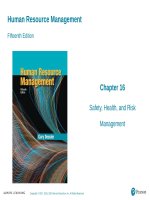Human resource management 8e by gomez mejia 2016 chapter 02
Bạn đang xem bản rút gọn của tài liệu. Xem và tải ngay bản đầy đủ của tài liệu tại đây (1.57 MB, 25 trang )
Chapter 2
Managing Work Flows and
Conducting Job Analysis
Copyright © 2016 Pearson Education, Inc.
2-1
Chapter Challenges
1. Understand the organizational
perspective of work
2. Understand the group perspective of
work
3. Understand the individual perspective of
work
4. Develop competence in designing jobs
and conducting job analysis
Copyright © 2016 Pearson Education,
Inc.
2-2
Chapter Challenges
4. Have familiarity with the flexible
workforce
5. Maintain human resource information
systems
Copyright © 2016 Pearson Education, Inc.
2-3
Work: The Organizational
Perspective
Work Flow
Organizational
Structure
The way work is organized
to meet the organization’s
production or service
goals
The formal or informal
relationships between
people in an organization
Copyright © 2016 Pearson Education, Inc.
2-4
Work: The Organizational
Perspective
Strategy
Defender Strategy
Prospector Strategy
Copyright © 2016 Pearson Education,
Inc.
2-5
Work: The Organizational
Perspective
Designing the Organization
Bureaucratic Organization
Flat Organization
Boundaryless Organization
Copyright © 2016 Pearson Education,
Inc.
2-6
Bureaucratic
Organizations
Copyright © 2016 Pearson Education, Inc.
2-7
Flat Organizations
Copyright © 2016 Pearson Education,
Inc.
2-8
Boundaryless
Organizations
Copyright © 2016 Pearson Education, Inc.
2-9
Work-Flow Analysis
Examines how:
• Work creates or adds value to the ongoing
process in a business
• Work moves from the customer through the
organization and then as a product or service
• Some steps or jobs can be eliminated, combined,
or simplified
• Alignment between employees’ work and
customer needs is arranged
Copyright © 2016 Pearson Education, Inc.
2-10
Business Process
Reengineering (BPR)
Copyright © 2016 Pearson Education, Inc.
2-11
Work: The Group
Perspective
Teams
•
•
•
•
•
Small number of people
Five or six considered optimal number
Complementary skills
Vital in flat organizations
Boundaryless organizations
Copyright © 2016 Pearson Education, Inc.
2-12
Work: The Group
Perspective
Types of Teams
• Self-Managed Team
o Members usually cross-trained
• Problem-Solving Teams
o Volunteer members; temporary
• Special-Purpose Teams (task force)
o Complex issues
• Virtual Teams
o Geographically dispersed
Copyright © 2016 Pearson Education, Inc.
2-13
Work: The Individual
Perspective
Motivation
•
•
•
•
Two-Factor Theory
Work Adjustment Theory
Goal-Setting Theory
Job Characteristics Theory
Copyright © 2016 Pearson Education, Inc.
2-14
Job Characteristics Theory
Copyright © 2016 Pearson Education,
Inc.
2-15
Job Design
The process of organizing work into
the tasks required to perform a
specific job
Copyright © 2016 Pearson Education, Inc.
2-16
Five Approaches to
Job Design
•
•
•
•
•
Work Simplification
Job Enlargement
Job Rotation
Job Enrichment
Team-Based Design
Copyright © 2016 Pearson Education, Inc.
2-17
Job Analysis
The systematic process of collecting
information used to make decisions about
jobs. Job analysis identifies the task,
duties, and responsibilities of a job.
Copyright © 2016 Pearson Education, Inc.
2-18
Sample Task by KSA
Matrix
Copyright © 2016 Pearson Education, Inc.
2-19
Guidelines for Conducting
a Job Analysis
1. Determine the desired applications of the job analysis
2. Select the jobs to be analyzed
3. Gather the job Information
4. Verify the accuracy of the job information
5. Document the job analysis by writing a job description
Copyright © 2016 Pearson Education, Inc.
2-20
Job Description
Copyright © 2016 Pearson Education, Inc.
2-21
Emerging Trends: Flexible
Schedules
Contingent Workers
Temporary employees
Part-time employees
Outsourcing/subcontracting
Contract workers
College Interns
Copyright © 2016 Pearson Education, Inc.
2-22
HRIS Applications
Copyright © 2016 Pearson Education, Inc.
2-23
Summary and
Conclusions
• Work: The Organizational Perspective
o Business strategy determines structure
• Work: The Group Perspective
o Various team structures
• Work: The Individual Perspective
o Motivation
• Designing Jobs and Conducting Job Analysis
o Process of designing and organizing work into specific jobs
• The Flexible Workforce
o Present in dynamic markets
• Human Resource Information Systems
Copyright © 2016 Pearson Education, Inc.
2-24
Pearson Education, Inc.
Copyright
Copyright © 2016 Pearson Education, Inc.
2-25









